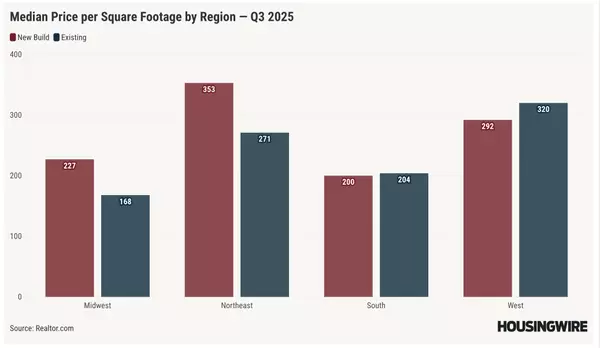The Government Shutdown Is Hitting the Housing Market Hard—and Florida Shows What’s at Stake

While Congress remains at a standstill, the effects of the federal government shutdown are beginning to ripple through Florida’s housing market—and the fallout could soon reach the rest of the country.
The warning signs are mounting. Flood insurance renewals are in limbo as the National Flood Insurance Program sits frozen. Builders are bracing for added delays, as the shutdown leaves few federal staff available to process key environmental permits. Homebuyers are seeing federal loans stalled. And what started as a bureaucratic pause is now threatening one of the state’s most powerful economic engines: real estate.
That’s no small thing in Florida, where the housing sector doesn’t just shape the market—it is the market. Real estate accounts for 24.1% of Florida’s gross domestic product, the largest share of any state, according to a May 2024 report from the National Association of Realtors®.
"Real estate accounts for nearly 20% of the U.S. economy, touching every community and driving millions of jobs," writes NAR's Executive Vice President and Chief Advocacy Officer Shannon McGahn. "Each additional day of uncertainty threatens programs that help buyers, sellers, and property owners navigate an already challenging market."
Nationwide, housing contributes about 18% to the GDP, or roughly $4.9 trillion. But in Florida, every home sale packs an even bigger punch. Each median-priced sale generates about $125,000 in local economic activity and supports roughly two jobs through construction, retail, and home services, according to the same report.
“Given Florida’s large share of national housing activity, even a modest pullback in buyer engagement could visibly nudge national sales and inventory metrics,” says Realtor.com® senior economist Anthony Smith.
In other words: What happens to housing in Florida doesn’t stay in Florida. As the shutdown stretches on, the state’s slowdown could become a warning sign for the national economy.
A storm within a storm: The NFIP lapse
Nowhere are the consequences more visible than on Florida’s coasts and low-lying wetlands. The state sits at the center of the nation’s flood risk, with nearly 1.8 million National Flood Insurance Program (NFIP) policies—more than one-third of all active policies nationwide, according to FEMA data.
With NFIP authorization suspended, that coverage is now in limbo. Assuming that each month has roughly an equal share of policies that expire, roughly 150,000 policies are up for renewal every month in Florida alone. And while a 30-day grace period allows lapsed policies to be reinstated, that buffer is shrinking fast.
If the shutdown stretches past late October, thousands of homeowners could find themselves uninsured in the middle of hurricane season. Meteorologists say that, so far, the nation has been lucky to avoid a direct landfall from a major storm. But that luck won’t hold forever—and if a storm hits while thousands of homeowners are between policies, the financial fallout could be catastrophic.
That risk is precisely why most lenders require flood insurance for homes in high-risk areas. For now, Fannie Mae and Freddie Mac have relaxed flood insurance requirements, allowing an estimated 1,300 home sales per day that require flood coverage to keep moving. Existing policies can also be transferred to new buyers—but only while they remain active.
New-construction buyers, however, don’t have the same safety net. With no existing policy to assume from a previous owner, they’re left unable to secure new coverage until Congress restores NFIP authority—leaving thousands of new-home closings at risk if the shutdown drags on.
“If the shutdown stretches into weeks, we’d expect to see a buildup of pending sales in flood-exposed areas as closings are delayed until NFIP authority is restored,” explains Smith.
Builders' rebound on pause
Meanwhile, Florida’s construction industry had only recently found its footing after years of shortages and recent price corrections.
In late July, the PulteGroup, the third-largest homebuilder in the U.S., announced that new orders in Florida were up 2% compared to the same period last year.
It was welcome, if unexpected, news. Just months before, homebuilding giant KB Homes announced that it was cutting new-home prices by $30,000. Against that backdrop, Pulte’s surge in orders seemed to signal a cautious turning point. Now, that momentum is once again in jeopardy.
NFIP delays "could add to the active inventory and delisting ratios, especially in metros already seeing sellers pull listings when offers fall short. Buyers and agents could hit pause on flood-zone properties, creating a short-term bottleneck followed by a post-shutdown rebound in closings,” explains Smith.
The top of the funnel for construction is also at risk as key federal permits required under Section 404 of the Clean Water Act—which governs the discharge of materials into wetlands and waterways—are expected to be delayed.
Almost 90% of Environmental Protection Agency workers have been furloughed, according to reporting from the New York Times, leaving few federal staff to review or approve pending applications and threatening to stall upcoming projects before they even break ground.
Samuel Staley, director of the DeVoe L. Moore Center at Florida State University, told Realtor.com in August that he estimated Florida needed at least 100,000 housing units to meet demand in the state. That’s a sizable shortage that will take sustained new construction to meet.
The Sunshine State isn’t alone. It’s estimated that nationally, there’s a shortage of nearly 4 million housing units—a gap in supply that would take seven years to fix at the current pace of construction.
If builder confidence falters at this critical juncture, it could jeopardize more than just Florida’s rebound. New construction remains one of the few pressure valves left in a market already straining under affordability pressures, helping to temper prices and expand supply. If that pipeline seizes up again, it risks prolonging the housing shortage that’s weighed on buyers for years.
How it all adds up: Loans, closings, and confidence
Also at risk are federal loan programs that have buoyed affordability for thousands of homebuyers.
FHA and USDA loans are lifelines for first-time and rural homebuyers. But now, they are delayed or halted as agency staff remain furloughed. Those disruptions may seem bureaucratic, but they can stop a closing in its tracks.
Florida ranks as the seventh-largest recipient of USDA housing funds, receiving about $327 million this year for single-family and multifamily programs so far this year, according to data from the USDA. That flow of financing has now been cut off, leaving borrowers and lenders in limbo.
The same is true for FHA lending, which underpins a large share of entry-level purchases. In June alone, FHA loans in Florida totaled roughly $2.4 billion, the third-highest volume of any state after California and Texas, according to the agency’s monthly snapshot.
In a housing market already grappling with high mortgage rates and slowing demand, these interruptions do more than delay paperwork—they erode confidence. Each stalled loan or postponed closing ripples outward, weighing on builders, agents, and buyers alike, and adding yet another layer of uncertainty to a market that can ill afford it.
What happens next
It’s unclear how long the shutdown will last, but each day its toll on the housing market grows more visible. Smith says Florida’s next few weeks could serve as a bellwether.
“If the state’s large, flood-exposed markets weather the shutdown with only a brief dip in activity, that would suggest a contained national effect,” he explains. “But if delayed closings snowball into broader pullbacks in offers or price adjustments, it could foreshadow a deeper fourth-quarter slowdown in U.S. housing data.”
And because housing underpins nearly one-fifth of the U.S. economy, even a small slowdown can ripple widely—affecting everything from construction jobs to consumer confidence.
“More broadly, Florida highlights how policy uncertainty can amplify cyclical transitions,” Smith adds. “The state is already normalizing after pandemic-era overheating. A shutdown could briefly accelerate that cooling before the next stabilization phase.”
With its outsize dependence on real estate and exposure to federal programs, Florida has become a test case for what the rest of the country may soon face: stalled sales and fading confidence in one of the nation’s most important economic engines.
Categories
Recent Posts











"My job is to find and attract mastery-based agents to the office, protect the culture, and make sure everyone is happy! "
